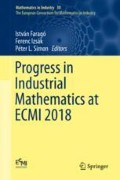Abstract
These days, techniques belonging to the research field of Artificial Intelligence (AI) are widely applied and used. Researchers increasingly understand the possibilities and advantages of those techniques for new types of tasks as well as for solving problems which are studied for years and solved by well known solution techniques so far. We focus on Reinforcement Learning (RL) [14] in the context of optimal control problems. We point out the similarities and differences between RL and classical optimal control systems and stress advantages of RL applied to biomechanical systems.
Access this chapter
Tax calculation will be finalised at checkout
Purchases are for personal use only
References
Abadi, M., Agarwal, A., Barham, P., Brevdo, E., Chen, Z., Citro, C., Corrado, G.S., Davis, A., Dean, J., Devin, M., Ghemawat, S., Goodfellow, I., Harp, A., Irving, G., Isard, M., Jia, Y., Jozefowicz, R., Kaiser, L., Kudlur, M., Levenberg, J., Mané, D., Monga, R., Moore, S., Murray, D., Olah, C., Schuster, M., Shlens, J., Steiner, B., Sutskever, I., Talwar, K., Tucker, P., Vanhoucke, V., Vasudevan, V., Viégas, F., Vinyals, O., Warden, P., Wattenberg, M., Wicke, M., Yu, Y., Zheng, X.: TensorFlow: large-scale machine learning on heterogeneous systems (2015). Software available from tensorflow.org
Brockman, G., Cheung, V., Pettersson, L., Schneider, J., Schulman, J., Tang, J., Zaremba, W.: Openai gym. CoRR (2016). abs/1606.01540
Coady, P.: Ai gym workout (2017). https://learningai.io/projects/2017/07/28/ai-gym-workout.html. Cited 26 Oct 2018
Deisenroth, M., Rasmussen, C.: PILCO: a model-based and data-efficient approach to policy search. In: Proceedings of the 28th International Conference on Machine Learning, ICML, pp. 465–472 (2011)
Gerdts, M.: Optimal Control of ODEs and DAEs. De Gruyter Textbook. De Gruyter, Berlin (2011)
Hill, A.V.: The heat of shortening and the dynamic constants of muscle. Proc. R. Soc. Lond. B Biol. Sci. 126(843), 136–195 (1938)
Kidzinski, L., Mohanty, S.P., Ong, C.F., Hicks, J.L., Carroll, S.F., Levine, S., Salath, M., Delp, S.L.: Learning to Run Challenge: Synthesizing Physiologically Accurate Motion Using Deep Reinforcement Learning. CoRR (2018). abs/1804.00198
Kullback, S.: Information Theory and Statistics. Wiley, New York (1959)
Kullback, S., Leibler, R.A.: On Information and Sufficiency. Ann. Math. Stat. 22(1), 79–86 (1951)
Puterman, M.L.: Markov Decision Processes: Discrete Stochastic Dynamic Programming, 1st edn. Wiley, New York (1994)
Schulman, J., Levine, S., Abbeel, P., Jordan, M.I., Moritz, P.: Trust Region Policy Optimization. In: ICML. Lille, France, pp. 1889–1897 (2015)
Schulman, J., Moritz, P., Levine, S., Jordan, M.I., Abbeel, P.: High-Dimensional Continuous Control Using Generalized Advantage Estimation. CoRR (2015). abs/1506.02438
Schulman, J., Wolski, F., Dhariwal, P., Radford, A., Klimov, O.: Proximal Policy Optimization Algorithms. CoRR (2017). abs/1707.06347
Sutton, R.S., Barto, A.G.: Introduction to Reinforcement Learning, 1st edn. MIT Press, Cambridge (1998)
Watkins, C.J.C.H., Dayan, P.: Q-learning. Machine Learning 8(3), 279–292 (1992)
Williams, R.J.: Simple statistical gradient-following algorithms for connectionist reinforcement learning. Machine Learning 8(3), 229–256 (1992)
Author information
Authors and Affiliations
Corresponding author
Editor information
Editors and Affiliations
Rights and permissions
Copyright information
© 2019 Springer Nature Switzerland AG
About this paper
Cite this paper
Gottschalk, S., Burger, M. (2019). Reinforcement Learning in Order to Control Biomechanical Models. In: Faragó, I., Izsák, F., Simon, P. (eds) Progress in Industrial Mathematics at ECMI 2018. Mathematics in Industry(), vol 30. Springer, Cham. https://doi.org/10.1007/978-3-030-27550-1_66
Download citation
DOI: https://doi.org/10.1007/978-3-030-27550-1_66
Published:
Publisher Name: Springer, Cham
Print ISBN: 978-3-030-27549-5
Online ISBN: 978-3-030-27550-1
eBook Packages: Mathematics and StatisticsMathematics and Statistics (R0)



